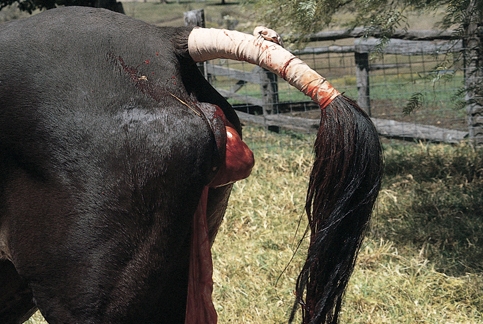Equine Reproduction and Stud Medicine Q&A 20
| This question was provided by Manson Publishing as part of the OVAL Project. See more Equine Reproduction and Stud Medicine questions |
A foaling mare is presented with dystocia. A manual examination finds a live foal in normal presentation; however, your findings indicate a caesarean section is likely to be the most successful means of delivery of a live foal.
| Question | Answer | Article | |
| What conditions in the mare and foal would indicate the need for a caesarean section? | (1) A narrow pelvic canal; (2) an oversize foal; (3) a malpositioned live foal which cannot be manipulated to the normal position; (4) arthrogryposis; (5) dead foals where a fetotomy cannot be performed safely; (6) rupture of the abdominal musculature.
|
[[|Link to Article]] | |
| What surgical approaches can you use? | (1) Low left flank approach is useful in large draught mares with large foals. An advantage is less myositis than when the mare is in dorsal recumbency; disadvantages are limited exposure; it is more difficult for deformed foals and for uterine torsion.
(2) Caudal ventral midline approach. Advantages are it is a common familiar site for surgery, there is little haemorrhage from linea alba and exposure is better; disadvantages are the possibility of myositis from prolonged recumbency on the back muscles and it is more difficult to lift the foal out of the abdomen. |
[[|Link to Article]] | |
| What complications can occur in mares during caesarean section and how would you manage them? | (1) Contamination of abdominal cavity by uterine contents: expose the uterus and locate the feet, pull the uterus up and pack off with drapes; a heavy stay suture can also be placed each end of the intended incision to hold the uterine edges up after delivery of the foal.
(2) Tearing of the uterine wall due to too small an incision: make sure the uterine incision is enlarged by surgical cut, not tearing. (3) Control of uterine haemorrhage (which can be profuse): if the placenta is easily detached, remove it; if not, free back the placenta for 3 cm around the rim of the incision and place a continuous suture along each edge of the incision to control haemorrhage. Be very careful not to include allantochorion in the sutures. (4) Leakage of uterine lochia: use an appropriate suture pattern to close the incision. (5) Peritonitis from uterine lochia: lavage the abdominal cavity with warm normal saline and aspirate; a final wash should contain penicillin and gentamycin. |
[[|Link to Article]] | |
| What post-operative complications can occur and how would you manage them? | A retained placenta:
(1) IV drip oxytocin 50 IU in 1 litre of saline solution over 1 hour if the placenta is not passed during the anaesthetic recovery period or use 20–40 IU oxytocin IM every hour. (2) Contamination infection of the vagina, cervix and uterus: where trauma to the vagina, cervix, etc. has occurred prior to caesarean section, and with prolonged placental retention, use gentle uterine lavage with warm normal saline commencing 24 hours post-operatively; avoid over-distension. (3) Postsurgical dehydration and infection: use IV fluids, parenteral antibiotics and NSAIDs for 3–5 days. Reassess the need for further treatment each day. (4) Post-surgical ileus and/or constipation: use a laxative diet and make sure the mare drinks water or is given IV fluids. (5) Swelling of limbs: increase hand walking exercise or turn out in a small paddock 3–4 times daily. (6) Post-surgical complications related to any abdominal surgery: incisional infection, wound dehiscence, colic due to bowel injury during parturition or during surgery and laminitis. |
[[|Link to Article]] | |
